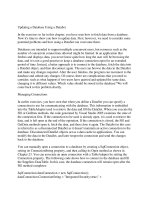Tài liệu processing queries by using explicit cursors ppt
Bạn đang xem bản rút gọn của tài liệu. Xem và tải ngay bản đầy đủ của tài liệu tại đây (232.64 KB, 34 trang )
Processing Queries by Using
Explicit Cursors
24
Introduction to Oracle: SQL and PL/SQL Using Procedure Builder24Ć2
Processing Queries by Using Explicit Cursors 24Ć3
Objectives
You may need to use a multiple row SELECT statement within PL/SQL to
process many rows. To accomplish this, you declare and control explicit cursors,
which are used in loops, including the cursor FOR loop.
At the end of this lesson, you should be able to
D Explain the difference between implicit and explicit cursors.
D Declare and use explicit cursors to fetch rows from the database.
D Create an explicit cursor containing parameters.
D Write cursor FOR loops.
Introduction to Oracle: SQL and PL/SQL Using Procedure Builder24Ć4
Processing Queries by Using Explicit Cursors 24Ć5
Overview
The Oracle7 Server uses work areas called “private SQL areas” to execute SQL
statements and store processing information. PL/SQL cursors let you name a private
SQL area and access its stored information. The cursor directs all phases of
processing.
Cursor Type
Description
Implicit Declared by PL/SQL implicitly for all DML and PL/SQL
SELECT statements.
Explicit Declared and named by the programmer and manipulated
through specific statements within the block’s executable
actions.
Recall that the SELECT statement in PL/SQL must only return a single row. PL/SQL
actually attempts to fetch two rows from an implicit cursor: one to satisfy the query,
and a second to see if further rows were returned. One method to eliminate this extra
fetch is to use an explicit cursor.
Explicit Cursor Functions
D Can process beyond the first row returned by the query, row by row.
D Keep track of which row is currently being processed.
D Allow the programmer to manually control them in the PL/SQL block.
Introduction to Oracle: SQL and PL/SQL Using Procedure Builder24Ć6
Processing Queries by Using Explicit Cursors 24Ć7
Controlling Explicit Cursors
Now that you have a conceptual understanding of cursors, review the steps to use
them. The syntax for each step follows on the next pages.
Controlling Explicit Cursors Using Four Commands
1. Declare the cursor.
Declare the cursor by naming it and defining the structure of the query to be
performed within it.
2. Open the cursor.
The OPEN statement executes the query and binds any variables that are
referenced. Rows identified by the query are called the active set and are now
available for fetching.
3. Fetch data from the cursor.
The FETCH statement loads the current row from the cursor into variables. Each
fetch causes the cursor to move its pointer to the next row in the active set.
Therefore, each fetch will access a different row returned by the query.
In the flow diagram on the left page, each fetch tests the cursor for any existing
rows. If rows are found, it loads the current row into variables, else it closes the
cursor.
4. Close the cursor.
The CLOSE statement releases the active set of rows. It is now possible to reopen
the cursor to establish a fresh active set.
Introduction to Oracle: SQL and PL/SQL Using Procedure Builder24Ć8
Processing Queries by Using Explicit Cursors 24Ć9
Controlling Explicit Cursors continued
Declaring the Cursor
Use the CURSOR statement to declare an explicit cursor. You can define parameters
to allow substitution of values into the query when the cursor is opened. You can also
reference variables within the query, but you must declare them before the cursor
statement.
Syntax
DECLARE
CURSOR cursor_name IS
select_statement;
where: cursor_name is a PL/SQL identifier.
select_statement is a SELECT statement without an INTO
clause.
Note: Do not include the INTO clause within the cursor declaration because it
appears later within the FETCH statement.
1
Introduction to Oracle: SQL and PL/SQL Using Procedure Builder24Ć10
Processing Queries by Using Explicit Cursors 24Ć11
Controlling Explicit Cursors continued
Opening the Cursor
Open the cursor to execute the query and identify the active set after specifying
values for all input variables. The cursor will now point to the first row in the active
set.
Syntax
OPEN cursor_name;
where: cursor_name is the name of the previously-declared cursor.
Note: If the query returns no rows when the cursor is opened, PL/SQL does not raise
an exception. However, you can test the cursor’s status after a fetch.
2
Introduction to Oracle: SQL and PL/SQL Using Procedure Builder24Ć12
Processing Queries by Using Explicit Cursors 24Ć13
Controlling Explicit Cursors continued
Fetching Data from the Cursor
Use the FETCH statement to retrieve the current row values into output variables.
After the fetch, you can manipulate the variables by further statements.
Syntax
FETCH cursor_name INTO variable1, variable2, . . .;
where: cursor_name is the name of the previously declared cursor.
variable is an output variable to store the results.
Guidelines
D Include the same number of variables within the INTO clause of the FETCH
statement as output columns in the SELECT statement, and be sure that the
datatypes are compatible.
D Match each variable to correspond to the columns positionally.
D Alternatively, define a record for the cursor and reference the record in the
FETCH INTO clause.
D Test to see if the cursor contains rows. If a fetch acquires no values, that is, there
are now rows left to process in the active set and no error is recorded.
3
Introduction to Oracle: SQL and PL/SQL Using Procedure Builder24Ć14
Processing Queries by Using Explicit Cursors 24Ć15
Controlling Explicit Cursors continued
Closing the Cursor
Close the cursor after completing the processing of the SELECT statement. This step
allows the cursor to be reopened, if required. Therefore, you can establish an active
set several times.
Syntax
CLOSE cursor_name;
where: cursor_name is the name of the previously declared cursor.
Note: Do not attempt to fetch data from a cursor once it has been closed or the
INVALID_CURSOR exception will be raised.
4
Introduction to Oracle: SQL and PL/SQL Using Procedure Builder24Ć16
Processing Queries by Using Explicit Cursors 24Ć17
Explicit Cursor Attributes
As with implicit cursors, there are four attributes for obtaining status information
about a cursor. When used, the attribute name is preceded by the cursor identifier.
Cursor Attribute
Description
%ISOPEN Boolean attribute that evaluates to TRUE if the cursor is
open.
%NOTFOUND Boolean attribute that evaluates to TRUE if the most recent
fetch does not return a row.
%FOUND Boolean attribute that evaluates to TRUE until the most
recent fetch does not return a row; complement of
%NOTFOUND.
%ROWCOUNT Numeric attribute that evaluates to the total number of rows
returned so far.
Note: Do not reference cursor attributes directly within a SQL statement.
Controlling Multiple Fetches from Explicit Cursors
Typically, when you want to process several rows from an explicit cursor, you define
a loop to perform a fetch on each iteration. Eventually, all rows in the active set will
be processed, and an unsuccessful fetch sets the %NOTFOUND attribute to TRUE.
Use the explicit cursor attributes to test success of each fetch before any further
references are made to the cursor. If you omit an exit criteria, an infinite loop will
result.
For more information, see
PL/SQL User’s Guide and Reference, Release 2.3 “Using Cursor Attributes” section.
Introduction to Oracle: SQL and PL/SQL Using Procedure Builder24Ć18
Processing Queries by Using Explicit Cursors 24Ć19
Explicit Cursor Attributes continued
You can only fetch rows when the cursor is open. Determine whether the cursor is
open using the %ISOPEN cursor attribute, if necessary.
Fetch rows in a loop. Determine when to exit the loop by using cursor attributes.
To retrieve an exact number of rows, fetch the rows in a numeric FOR loop, or fetch
the rows in a simple loop and determine when to exit the loop by using the
%ROWCOUNT cursor attribute.
Example
Retrieve the first five line items for an order one by one. Print the cumulative total for
each product to the screen.
PROCEDURE ord_process
(v_ord_id IN s_item.ord_id%TYPE)
IS
v_product_id s_item.product_id%TYPE;
v_item_total NUMBER (11,2);
v_order_total NUMBER (11,2) := 0;
CURSOR item_cursor IS
SELECT product_id, price * quantity
FROM s_item
WHERE ord_id = v_ord_id;
BEGIN
OPEN item_cursor;
LOOP
FETCH item_cursor INTO v_product_id, v_item_total;
EXIT WHEN item_cursor%ROWCOUNT > 5
OR item_cursor%NOTFOUND;
v_order_total := v_order_total + v_item_total;
TEXT_IO.PUT_LINE (’Product ID ’||
TO_CHAR(v_product_id)||
’ has a total of ’||
TO_CHAR(v_order_total,’$999,999,999.99’));
END LOOP;
CLOSE item_cursor;
END ord_process;
Note: If using %ROWCOUNT, add a test for no rows in the cursor by using the
%NOTFOUND attribute because the rowcount is not incremented if the fetch
does not retrieve any rows.
Introduction to Oracle: SQL and PL/SQL Using Procedure Builder24Ć20
Processing Queries by Using Explicit Cursors 24Ć21
Cursors and Records
We have already seen that you can define records to use the structure of columns in a
table. You can also define a record based on the selected list of columns in an explicit
cursor. This is convenient for processing the rows of the active set since you can
simply fetch into the record. Therefore, the values of the row are loaded directly into
the corresponding fields of the record.
In the example, you can select the ROWID pseudo-column, and it will have a
corresponding field within the EMP_RECORD PL/SQL record.
Introduction to Oracle: SQL and PL/SQL Using Procedure Builder24Ć22
Processing Queries by Using Explicit Cursors 24Ć23
Cursors with Parameters
Parameters allow values to be passed to a cursor when it is opened, and used within
the query when it executes. This means that you can open an explicit cursor several
times in a block, returning a different active set on each occasion.
Parameter datatypes are the same as those for scalar variables, but you do not give
them sizes. The parameter names are for references within the cursor’s query
expression.
Syntax
CURSOR cursor_name [(parameter_name datatype, )]
IS
select_statement;
where: cursor_name is a PL/SQL identifier for the previously
declared cursor.
parameter_name is the name of a parameter.
datatype is a scalar datatype of the parameter.
select_statement is a SELECT statement without the INTO
clause.
When the cursor is opened, you pass values to each of the parameters positionally.
You can pass values from PL/SQL or host variables as well as literals.
Introduction to Oracle: SQL and PL/SQL Using Procedure Builder24Ć24
Processing Queries by Using Explicit Cursors 24Ć25
Cursor FOR Loops
A cursor FOR loop processes rows in an explicit cursor. It is a shortcut because the
cursor is opened, rows are fetched once for each iteration in the loop, and the cursor
is closed automatically when all rows have been processed. The loop itself is
terminated automatically at the end of the iteration where the last row was fetched.
Syntax
FOR record_name IN cursor_name LOOP
statement1;
statement2;
. . .
END LOOP;
where: record_name is the name of the implicitly-declared record.
cursor_name is a PL/SQL identifier for the
previously-declared cursor.
Guidelines
D Do not declare the record that controls the loop. Its scope is only in the loop.
D Test the cursor attributes during the loop, if required.
D Supply the parameters for a cursor, if required, in parentheses following the
cursor name in the FOR statement.
D Do not use a cursor FOR loop when the cursor operations have to be handled
manually.









